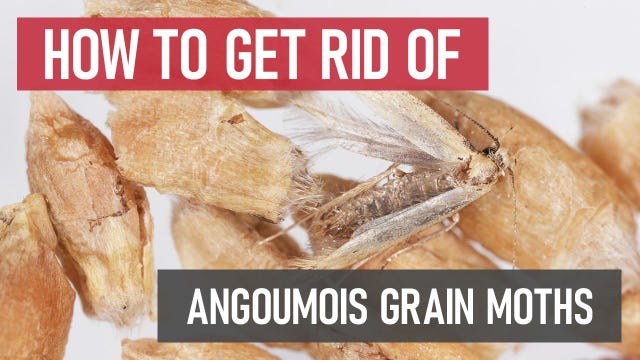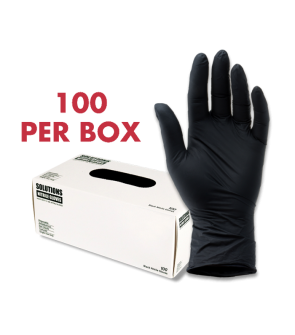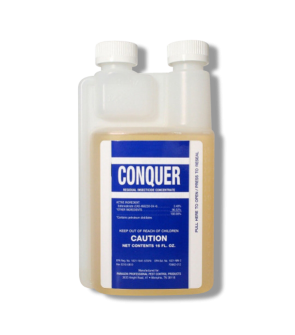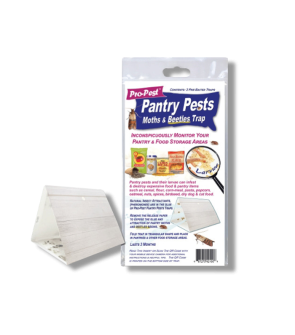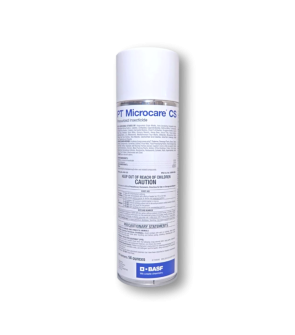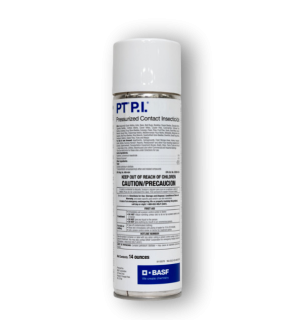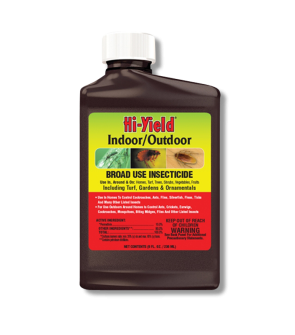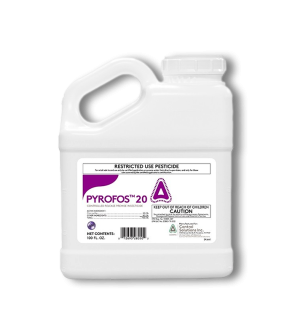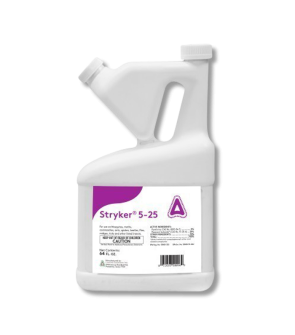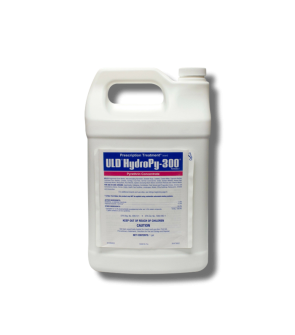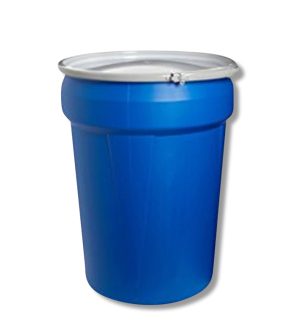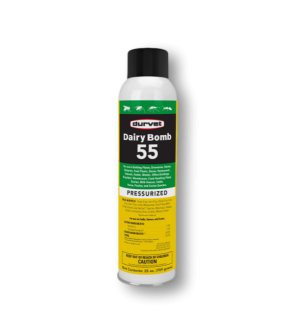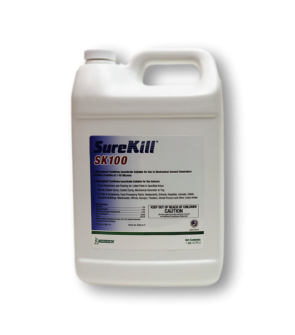Gain access to personalized product screening, the best pricing, rewards, and more!
Most Effective Products
Angoumois Grain Moth Control: How To Get Rid of Angoumois Grain Moths
This page is a general Angoumois grain moth control guide. Using the products and methods suggested you will get control of Angoumois grain moths. Follow this guide and use the recommended products and we guarantee 100% control of Angoumois grain moths.
A pantry pest that is a troublesome problem for crop growers and agricultural farmers is a bug known as the Angoumois grain moth, also known as the French grain moth, grain moth, rice grain moth, and small grain worm. These pests are found all over the world, and they like to infest crops and ears of corn in the United States. If left untreated, these pests can be a huge economic and financial threat to the agricultural industry and farmer livelihoods.
Angoumois grain moth populations can very quickly get out of control because of how frequently the adult females lay eggs. These bugs are most prevalent during warm weather conditions.
If you have discovered Angoumois grain moths in your home, our expert-made DIY guide can help you to clear your pantry of them once and for all by using our recommended advice and professional-grade products.
Identification
Before proceeding with treatment, you must be certain that the type of pest infestation you have is a species of Angoumois grain moth. Careless identification can lead you to use the wrong or ineffective insecticides, wasting your time and finances. Some identifying characteristics of Angoumois grain moths are explained below:

- Angoumois grain moth adults are small, tan to gray or yellowish-white moths about one-third inch long with a wingspan of 16 mm. They have fringe or hair-like scales all over its body and wings. Their forewings are pale yellow.
- The antennae of the Angoumois grain moth are thin, thread-like, and pale brown. They also possess 6 legs.
- Larvae are white in color with a yellow-brown head and reddish brown-mouthpart. These legless caterpillars are 3 mm when fully grown. They are rarely seen as they spend their life within their food source.
- The eggs of Angoumois grain moths are 2 mm long, oval in shape, and start off as white when first laid. After some time, these eggs turn red in color.
- As adults, these moths are commonly mistaken for clothes moths due to their similar sizes and colorations. The quickest way to tell one from the other is to identify the infestation source; Angoumois grain moths infest stored grains and are likely to be found near the pantry or in the kitchen. Clothes moths infest fabric, so you can expect them to be found near closets or wherever else clothes are stored. If you are unable to determine the source, take a closer look at the moths themselves. The hind wings of clothes moths have rounded tips, while the hind wings of Angoumois grain moths feature a thumb-like appendage at their wing tips.
Use the description and image above to help you identify the Angoumois grain moth. If you need further assistance, contact us, and one of our representatives will try to assist you.
Inspection
After you confirm that you are encountering Angoumois grain moths in your home, you can move on to Inspection. Identify the source of the infestation and remove the product immediately from your storage area.

Where To Inspect
Most Angoumois grain moths prefer to feed on grain, including corn, rice, millet, barley, sorghum, wheat, barley, oats, beans, and other seeds growing in field crops. They can also infest dried, shelled corn kept in bins.
While Angoumois grain moths can infest dry grains, they prefer damp grains.
Consequently, since this pest bores into these food items, they will be found indoors where they are stored. Examples are cereals, popcorn, oatmeal, rice, and more in kitchens, garages, cabinets, shelves, pantries, and other spaces where food is stored.
What To Look For
Angoumois grain moths do not leave webs like other pantry moths, but they will lay a cluster of 40 eggs on the food source surface. The newly hatched larvae will then burrow into the adjacent food item and leave behind exit holes.
The larvae create strong, foul odors that make the food bad. Other items stored near the infested food also become unappealing or inedible. Heavily infested grains, corn, rice, and other food items become discolored.
Because adult Angoumois grain moths do not live very long, their flying activities should be noted. These pests are more than likely breeding and laying eggs in the sites they are seen flying within.
Treatment
Once you have confirmed Angoumois grain moths activity, it is time to begin treatment. Remember to read all product labels and follow the application instructions on these labels and stay safe by wearing personal protective equipment (PPE).
The best method of controlling Angoumois grain moths, if you have an infestation in your pantry, is discarding all your stored dried food products, doing a detailed cleanup and vacuuming, then applying Novacide Aerosol to kill adults and halt the development of eggs and larvae. Finally, you should place Pro-Pest Pantry Moth and Beetle Traps to capture any stragglers.
Step 1: Preliminary Cleanup and Vacuuming

To treat an Angoumois grain moth infestation, the first step is to clean out your pantry. Start by throwing out boxed and bagged foodstuffs, essentially starting from scratch.
This may sound drastic, but it may be necessary to ensure that the Angoumois grain moth is no longer infesting items. You don't want to leave any food item to chance.
In the case of agricultural locations where grains are stored away in cribs, thoroughly examine the crib stored corn and discard any which are infested by the Angoumois grain moth.
If you seen these pest flying near these sites it may be safe to assume the corn is already infested. In this case, you should properly dispose of the top few inches of corn.
A detailed cleanup should take place and any harvesting equipment should be cleaned before reuse.
Next, vacuum inside the cabinets, shelves, and pantries where food goods are stored.
Set aside everything else from the pantry, then vacuum all cracks and crevices in the pantry’s shelving. Small pantry pests may be found in these tight spaces as they travel from product to product. Be sure to throw out the vacuum’s contents outdoors when you are done.
Wipe down the pantry shelves with water to clean up any food residue. Do not use any strong detergents or bleach, as these will keep pests away from the pesticides you will apply.
Finally, caulking should be used if these areas have cracks and crevices. This will prevent the infestation from spreading.
Any new food items you recently bought should be stored in a sealed, plastic container.
Step 2: Apply Novacide Aerosol
Once your pantry and food storage area is totally cleaned out, you should apply Novacide Flea & Tick Aerosol.
Novacide Flea & Tick Aerosol is a powerful insecticide that comes with an IGR (or Insect Growth Regulator) that will prevent the undeveloped stages of moths from developing into adults. The best part about Novacide is its residual effect as it can remain effective for up to 7 months so you don't have to apply often.
Just shake the can, hold it upside-down, and spray a barrier where shelving meets the wall.
Hold the can at arm’s length and direct the spray toward the area to be treated. Use a sweeping motion to apply the product and back away from the treated area while holding the can 36 inches away from the area being treated.
Spray the top, sides, corners, and bottom of the shelves, pantries, and cabinets.
Do not enter or allow others to enter the treated areas until vapors, mists, and aerosols have dispersed and the treated area has been thoroughly ventilated.
Moths that come into contact with the spray will have their nervous systems impacted and be rendered unable to function. Once it’s dried on the shelf surfaces, Novacide leaves a residual chemical effect that eliminates adult moths, prevents egg-laying, and stunts the growth of larvae, preventing them from developing into reproductive adults.
Step 3: Apply Pro-Pest Pantry Moth & Beetle Traps
Once Novacide Flea & Tick Aerosol has dried, continue monitoring the area with glue traps. Angoumois grain moth populations can quickly become out of control and rise up again so glue traps can help monitor and capture any larvae.
Pro-Pest Pantry Moth and Beetle Traps are an easy-to-use glue trap that comes with a pre-baited pheromone adhesive to lure and capture pantry moths and beetles.
Remove the paper from the adhesive. Next, fold the trap into a triangle or tent shape.
Place one Pro-Pest Pantry Moth and Beetle Traps per 300 sq. ft. for light to moderate infestations. For heavy infestations, set one trap per 100 sq. ft.
Set the Pro-Pest Pantry Moth and Beetle Traps where you have seen Angoumois grain moth activity or in sites where foods are stored.
Examples of sites where this trap can be placed are in the middle or corners of pantry shelves, cabinets, and more.
Check the Pro-Pest Pantry Moth and Beetle Traps weekly. If you notice an infestation, reapply Novacide Flea & Tick Aerosol and properly dispose of food items.
Dispose of these traps when full or when 90 days have passed.
Prevention
Once you have eliminated the Angoumois grain moth problem, don’t think that you will never encounter a pantry pest ever again. Angoumois grain moths are quite persistent and may make a comeback. Follow along with the preventative measures below to ensure Angoumois grain moths do not return:
- When buying dry foods at the grocery store, examine the packaging. If you can see the product through transparent packaging, try to look for any moths, larvae, or other evidence of infestation. If you see any holes, rips, tears, or other openings, pass that item up.
- It’s best to keep food in tight-fitting or sealed containers. Put cereals, grains, and flour in containers that can be tightly air-sealed. Pet food and bird seed are often overlooked and highly conducive for pantry pests, so it’s important to also store your pet food in sealed containers.
- Equipment used to harvest and store field crops should be thoroughly cleaned.
- Finally, keep up with regular pesticide applications to ensure protection throughout the year. With Novacide Flea & Tick Aerosol 7-month residual, we recommend you apply twice a year for preventative applications. Be sure to check traps regularly and replace them every 3 months. Continue monitoring food materials with Pro-Pest Pantry Moth and Beetle Traps.
Key Takeaways
What Are Angoumois Grain Moths?
- The Angoumois grain moth is known for causing significant damage to home pantries and agricultural areas where food is being grown or stored.
How to Get Rid of Angoumois Grain Moths
- To get rid of Angoumois grain moth infestations, thoroughly clean out your pantry and then apply Novacide Aerosol and Pro-Pest Pantry Moth and Beetle Traps.
Prevent Angoumois Grain Moth Reinfestations
- Prevent reinfestation of Angoumois grain moths by checking foods, reducing clutter and keeping pantries clean and neat. You can also use Novacide Aerosol preventatively every 7 months and monitor infestations with Pro-Pest Pantry Moth and Beetle Traps.






